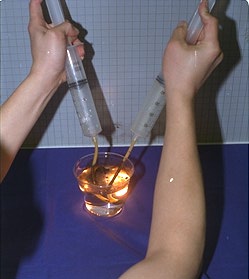The following five gases are also easy to make but require more skill to handle. Suitable for high school chemistry and up. These gases are toxic. Follow instructions carefully. Many of the experiments described make excellent classroom demonstrations (such as the ammonia fountain shown at right).
Ozone can be generated at a rate of 800 nanomoles/min using our easy-to-build microscale ozone generator. Lots of interesting experiments! Build your own! It can be stored on the shelf from year to year.
These five gases are not quite as simple to make. They cannot be made in a syringe at room temperature. Instead, a new technique (actually a 200-yr old technique) is used in which two chemicals are heated in a test tube while collecting the gas produced in a syringe. These do make great labs for better/advanced students working in pairs. The experiments with the gases are quite interesting and worth the effort! Some great demonstrations available for each gas!
These two gases pose special problems and should be done by teachers and chemists with experience with gas manipulation using syringes. These make good classroom demonstrations or labs for college-level chemistry majors (such as descriptive inorganic chemistry). These gases should only be made in a working fume hood in a university chemistry laboratory.

ammonia fountain

chemiluminescence

Underwater fire!